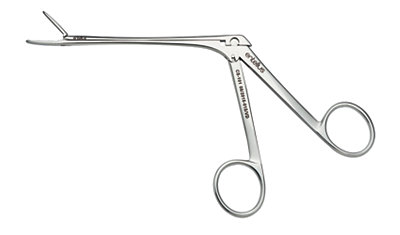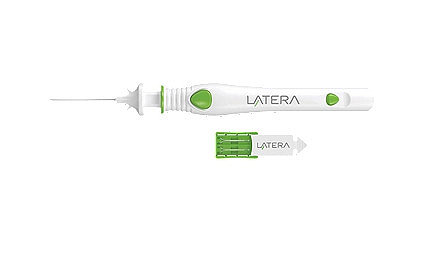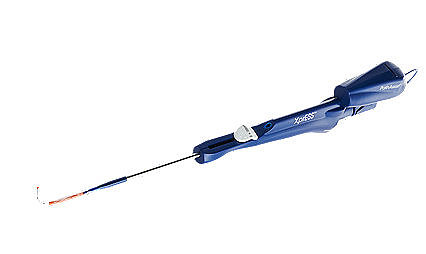Instruments
The MiniFESS® family of ENT surgical instruments is designed to streamline and optimize FESS procedures. When used in conjunction with the Stryker ENT portfolio, these ENT surgical instruments assist you in delivering consistent and quality patient outcomes.

Available options

MiniFESS alar retractor
Designed for easy eversion of the ala during implantation procedures such as with the Latera® absorable implant system.1
Features and benefits
- Handle design is tailored to allow easy and controlled eversion of the nasal ala
- Short length: designed to optimize ergonomics
- Hooks: designed for a secure grip with minimal trauma to the tissue
- Reusable
MiniFESS suctions
The MiniFESS suctions were designed to enhance your current line of surgical instrumentation.
Features and benefits
- Small diameter to help access the sinuses
- Simple attachment point for navigation cases when used as a surgical instrument with the Stryker ENT navigation system universal clamp2

MiniFESS sickle knife
The MiniFESS sickle knife can be used in a wide variety of procedures.
Features and benefits
- 10mm curved blade
- Ergonomically designed


MiniFESS forceps
Designed for removal of bone or cartilage and gentle soft tissue compression.
The MiniFESS line of forceps include:
- MiniFESS turbinate forceps (110mm working length and 5x19mm jaws)
- MiniFESS Blakesly forceps (Available in straight, 45-degree and 90-degree angles)
- MiniFESS Takahashi forceps (110mm working length and 2.5x7mm jaws)
MiniFESS surgical instrument sets
These ENT instrument sets are designed for your FESS procedures.
The MiniFESS surgical instruments set includes the following instruments:
- Blakesley forceps (Straight, 45 degree, 90 degree)
- Blakesley forceps Thru-Cut (Straight, 45 degree)
- Takahashi forceps
- Turbinate forceps
- Sickle knife
- MiniFESS sterilization tray


MiniFESS maxillary seeker
Using 120-degree and 135-degree entry angles, these reusable maxillary seekers offer a way to confirm the location of the maxillary ostium.
Features and benefits
- Versatile double-ended profile
- Ergonomically designed
MiniFESS sphenoid seeker/freer
The sphenoid seeker/freer is designed as a two-in-one tool.
Features and benefits
- The ball-tip seeker, with 19-degree bend, is designed to navigate around the superior turbinate to locate the sphenoid ostium


MiniFESS light seeker
The light seeker allows you to leverage the unique combination of illuminated guidance and tactile feedback of a sinus seeker.
Features and benefits
- Utilizes red light and three adjustable settings for confirmation
MiniFESS sterilization tray
This autoclavable sterilization tray for MiniFESS surgical instruments holds eight finger-grip and six seeker-style instruments. Organize and protect your MiniFESS instruments with a tray intended to allow sterilization of the enclosed medical devices during a prevacuum steam sterilization cycle, in conjunction with a legally marketed wrap. The tray is not intended to maintain sterility on its own.3
Features and benefits
- Aluminum construction with silicone instrument holders
- Latched cover
- Perforations allow sterilant penetration
- Protects MiniFESS instruments during sterilization, storage and transportation

Stryker ENT navigation system powered by Scopis®
The Stryker ENT navigation system powered by Scopis software, is a next -generation solution for navigating functional endoscopic sinus surgery. It offers image guidance and visualization in a single system.4
LEARN MORE

LATERA® absorbable nasal implant
The LATERA absorbable nasal implant supports the upper and lower lateral cartilage by anchoring above the maxilla to provide cantilever support.5,6 Nasal airway obstruction (NAO) is one of the most common complaints among patients who see an ENT physician, and its treatment can result in significant improvements in quality of life.7
LEARN MORE

XprESS® ENT dilation system
The XprESS ENT dilation system delivers control and versatility for balloon dilation. Its seeker-based design and tip malleability provides tactile feel and flexibility to address complex anatomy for a broad range of patients.8,9
LEARN MORE

FocESS® Sinuscopes
Designed for use with FocESS 3mm sinuscopes, this medical imaging device uses WirelessHD technology to transmit clear images right to a mounted receiver, making extraneous cords, cameras, and light source equipment a thing of the past. These features were designed to enhance usability, image quality and patient comfort in the office setting.10
LEARN MORE
REFERENCES:
1. Alar retractor instructions for use: GA128 (Tontarra)
2. MiniFESS Suctions instructions for use GA129 (Tontarra)
3. MiniFESS sterilization tray instructions for use: 3258-001 (25916 Summit)
4. Stryker ENT Navigation system, instructions for use D0000009107
5. LATERA Instructions for Use 4645-002
6. San Nicoló, M., Stelter, K., Sadick, H., Bas, M., & Berghaus, A. (2018). A 2-Year Follow-up Study of an Absorbable Implant to Treat Nasal Valve Collapse. Facial Plast Surg, 34(5), 545-550xx Clinical data publication noted on page 12)
7. Chandra RK, Patadia MO, Raviv J. Diagnosis of nasal airway obstruction. Otolaryngol Clinic North Am. 2009;42(2):207-25
8. XprESS Instructions for Use 4322-001
9. Data on file at Stryker DHF 1656-001
10. FocESS Instructions for use: 25917 (Summit)
Disclaimer
This document is intended solely for the use of healthcare professionals. A surgeon must always rely on his or her own professional clinical judgment when deciding whether to use a particular product when treating a particular patient. We do not dispense medical advice and recommend that surgeons be trained in the use of any particular product before using it in surgery.
The information presented is intended to demonstrate Stryker’s products. A surgeon must always refer to the package insert, product label and/or instructions for use, including the instructions for cleaning and sterilization (if applicable), before using any of Stryker’s products. Products may not be available in all markets because product availability is subject to the regulatory and/or medical practices in individual markets. Please contact your representative if you have questions about the availability of Stryker’s products in your area.
Stryker or its affiliated entities own, use, or have applied for the following trademarks or service marks: MiniFESS, FocESS, LATERA, Scopis, Stryker and XprESS. All other trademarks are trademarks of their respective owners or holders.
The absence of a product, feature, or service name, or logo from this list does not constitute a waiver of Stryker’s trademark or other intellectual property rights concerning that name or logo.
ENT-INST-SYK-623051



